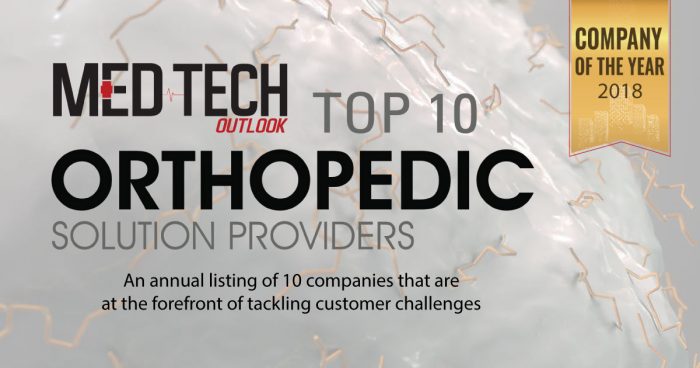Cerapedics named company of the year
Breaking new grounds in bone graft technology
According to the U.S. Census Bureau, every year more than 1.6 million bonegrafting procedures are performed in the U.S. alone, and in each case, surgeons are faced with the critical decision of choosing an appropriate bone graft technology. Today, the options available for bone graft substitutes are expansive, from demineralized bone matrix (DBM), allograft, ceramics, and cellular bone matrices to name a few. Yet if one were to take a closer look, the existing categories in bone graft are largely generic products, based on animal data with little to no human clinical evidence supporting it.

In an outcome-driven healthcare world, the lack of quality data and off-label bone graft substitutes prevents providers from delivering Accountable Care as well as adds to the possibility of medical complications.
Today, with over 400 bone graft technologies to choose from within a highly commoditized market, there are only two class III products that are based on level I clinical evidence in spine—one of them being i-FACTOR by Cerapedics. Setting a new paradigm in the science of bone repair, i-FACTOR is a peptide enhanced drug-device combination product and the only biologic bone graft that has a premarket approval from the FDA for use in the cervical spine. Keeping in mind that cost containment and quality care are the biggest imperatives for surgeons and hospitals alike, Dr. Jeffrey G. Marx, COO and president of Cerapedics states, “Our primary aim is to provide exceptional outcomes and better safety but all at a reasonable cost. We empower clients with a twofold advantage: an evidence-based technology and a price point that fits within the reimbursement landscape.” That said, while there are inexpensive bone grafting products in the market, nothing currently matches to the value that i-FACTOR brings.
A truly unique technology at its core, i-FACTOR is a cut above other available products when it comes to optimization of patient biology. It is an advanced biologic where a synthetic peptide (P-15) is manufactured chemically by stitching together constituent amino acids. P-15 replicates a peptide that is found naturally in Type I human collagen, responsible for cellular attachment in all mammalian connective tissues and particularly in bone. “When you take the P-15 found in i-FACTOR and place it on to an anorganic bone mineral (ABM), bone forming cells attach to the synthetically derived P-15 like they would in natural circumstances,” explains Marx. i-FACTOR’s state-of-the-art ‘Attract, Attach, and Activate’ mechanism amplifies native biological processes and allows for rapid and powerful bone formation with a benign safety profile.
In contrast, other categories of bone graft, for example synthetic bone grafts are characterized by passive processes where the results are highly subjective and dependent on a patient’s biology. On the other hand, DBMs claim to be osteoinductive, providing chemical materials to initiate bone formation. “However, the concentration of the proteins in the chemical materials is such that it makes inductivity in humans virtually impossible,” reveals Marx. More likely, cellular allograft materials appear to be dependent on the metabolic activity of living cells for their primary function and if that’s the case it would require an entirely different FDA pathway. “In short, it’s not certain what the value or mechanism of these products exactly is,” he adds.
Without a doubt, there is no contesting i-FACTOR’s dual differentiation—their next-gen technology and high-quality clinical evidence. In an investigational device exemption (IDE) study, where i-FACTOR was evaluated in a randomized, multicenter clinical trial, the solution emerged superior to autograft in overall clinical success. As part of the trial, patients underwent an anterior cervical discectomy and fusion and received either i-FACTOR bone graft or local autograft in a cortical allograft ring implanted into the target vertebral space. Ultimately, i-FACTOR demonstrated an overall 68 percent success as opposed to an autograft that exhibited a 56 percent success rate. In times when most osteobiologic products have no FDA-approved indications, i-FACTOR stands out as it’s proven and validated in clinically relevant real-world applications.
Behind Cerapedics’ novel technology is a team of life science veterans who have decades of combined experience in the medical devices industry. As an outcome of their strong leadership and foolproof technology, the company is gaining significant momentum in the bone graft spectrum. “A major reason behind our rapid growth is our holistic sales approach. We employ highly focused local distribution partners who are able to educate their customers with a science and databased story for long-term gains that our competitors just can’t match,” asserts Marx. In the recent past, the company has witnessed several success stories, where hospitals have replaced all their commercial and incumbent bone grafting technologies with i-FACTOR while simplifying interoperative care delivery.
The future holds even favorable prospects for Cerapedics. They are expecting continued commercial growth with i-FACTOR and have filed an IDE for the next generation version of their product in Transforaminal Lumbar Interbody Fusion (TLIF). In addition, the company will be approximately doubling their Colorado manufacturing facility in the second half of 2018, allowing them to build products ahead of their remarkable growth. To remain at the leading edge of osteobiologic science, Cerapedics will also invest substantially in conducting meaningful clinical studies to expand their body of evidence continually.
At the end of it all, i-FACTOR is indeed a revolutionary and a much-needed step toward a powerful and safe bone formation approach that is adding immeasurable value to health outcomes.
October 3rd 2018
